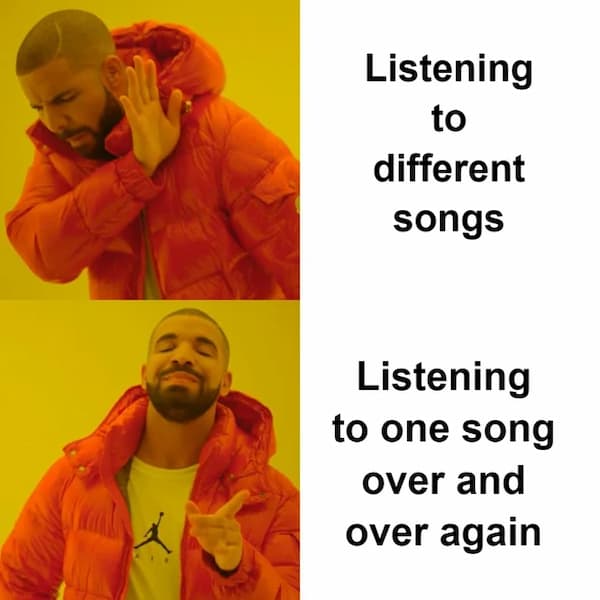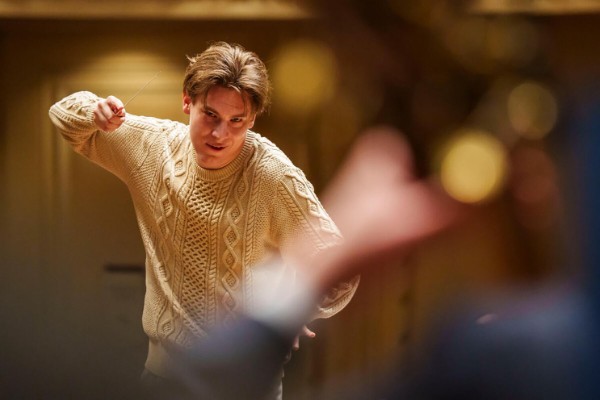In part one, we identified what musical repeatism is, why the contemporary technological landscape makes it uniquely possible, and the potential benefits of repeatism in regulating mood and enabling deep focus. We also touched on the idiosyncratic and highly personal nature of music-listening in general, and the fact that musical repeatism is often rarely acknowledged or sanctioned publicly and therefore may carry some stigma.

Our brain listening to the same piece of music on repeat (Image created by ChatGPT)
Stigma: let’s begin there. In the spheres in which I’ve moved, musicians have tended to associate positive musicality with proactivity: learning a piece, practicing, performing, composing, formal analysis, transcribing. Considerably less emphasis is placed on listening, whether active and engaged or simply as a way to spend time or understand one’s own preferences. At first glance, musical repeatism might seem very passive, and in some cases does result in the listener “tuning out” or ignoring the piece being repeated. However, what if musical repeatism could actually constitute a truly deep form of engaging with a composition or song, one that could inform one’s compositional practice, practical musicianship, and self-knowledge?
Listening to one song obsessively on repeat is very different from trying to get a handle on the development of a composer’s style over time, or trying to understand their overall output. It instead encourages deep familiarity with and understanding of one work. Regardless of genre, musical repeatism affords the opportunity to parse production elements and layers, to zoom in on particular timbres, to examine different musical relationships within the work, to think in turn about structure and storytelling, harmony and melody. It teaches us what moods we wish to sit in, what affects; it allows us to consider the mystery of lyrics or the way poetry has been set to music. Broadly, it forces us to face ourselves: when listening to one piece on repeat, we are forced to ask what exactly it is we are so drawn to in the musical experience in question. I would argue that repeatism might be as valuable to holistic musicianship as all of the proactive pursuits listed above. The artworks that affect us very deeply are able to tell us a lot about the world, ourselves, and what we value – especially if we get to know them exceptionally well.
There is no expiry date on this usefulness, either. I have never listened to something so many times that I then found it devoid of the power to move me or teach me something. For one thing, we might return to an object of our repeatism at a later date and see it with fresh eyes. As time passes, our bank of experience grows, continually generating new points of interpolation, reference, and tension. Songs we have repeated in this way also have a lovely quality à la perfume or Proust’s madeleines, with the power to transform us into versions of our past selves for a split, visceral second – with all the associated rush of memories and feelings. Indeed, there is something endearingly human about musical repeatism, in its temporary ignoring of mortality and ephemerality in favour of prolonging a beloved atmosphere and soundworld far past its original duration.
Rather than connoting low musical intelligence, a tendency towards musical repeatism might signal neurodivergence, and a particular propensity towards a certain kind of anticipation and reward, or a “sticky” quality to the brain. It might also come down to processing speed: some musicians thrive on rhythmic and harmonic complexity or even obfuscation and live in a permanent state of rapid musical processing, particularly if they love to sight-read, learn on the fly, or improvise. For musicians who prefer slow music, melancholy music, or simply find their thrill and stimulation in the subtle details, repeatism may appeal. Musical repeatists have also perhaps found greater haven and acceptance in other genres than classical music – jazz pianist Bill Evans confirmed in an interview with Marian McPartland his preference for meditating over one tune for long periods of time in practice, while South London electronic artist Burial’s litmus test for whether a loop or groove was worth building upon was living with it on repeat for veritable days at a time in his flat.
Bill Evans: Waltz for Debby (Matan Porat, piano)

How Music Works by David Byrne © The New York Public Library Shop
In his book How Music Works, David Byrne traces the history of the encore back to the 18th century rowdiness of the Italian opera house, La Scala, where opera-goers would raucously demand the return of the performer and the repeat of a particularly juicy musical moment. The instinct to repeat music can clearly be traced through history; it has, however, perhaps been unhealthily accelerated by the unique social media landscape in which we now live. Listening habits are increasingly influenced by short-form content and so-called “trending audio” – a particular piece of music becomes associated with a popular video format and can project even the most unknown of musicians into global fame within a bemusingly short period of time. After the pile-on of approval and attention also comes a discard reminiscent of fast fashion or planned obsolescence. In this way, musical repeatism has the danger of becoming a consumerist act of extracting every ounce of emotion from a work and then forgetting about it – or even recoiling from further encounters with the work as a “cringe” reminder of a bygone trend. Architect Zaha Hadid was one for whom musical repeatism, while helpful for her work in the initial “honeymoon stage,” always ultimately led to tiring of a particular work for good, over-familiarity breeding intolerance and dislike. In this way, musical repeatism can flirt with the boundary between treating artists and their labour with respect, or as creators of disposable products.
A far less compelling concern regarding musical repeatism is the question of respect for the composer’s intentions. The pristine listening conditions of the contemporary concert hall are an anomaly in the history of human musical activity; even canonised works of great classical import were booed, talked over, walked out of, and so forth. While many albums are designed to flow well, it’s rare that they are fully programmatic and must be listened to in order. With classical works with essential overarching structures, like the sonata, there is, of course, knowledge that can only be gleaned by hearing the whole thing. However, repeating sections of a sonata in isolation will also serve a musical and experiential purpose. Composer Erik Satie created the genre of “furniture music” in 1917 – music designed to “furnish” a room and provide a backdrop to the social effervescence of public spaces. It would be a rare composer indeed who was not flattered to discover that a person wished to live with their creation on repeat, woven into the very fabric of their days.
For more of the best in classical music, sign up for our E-Newsletter




